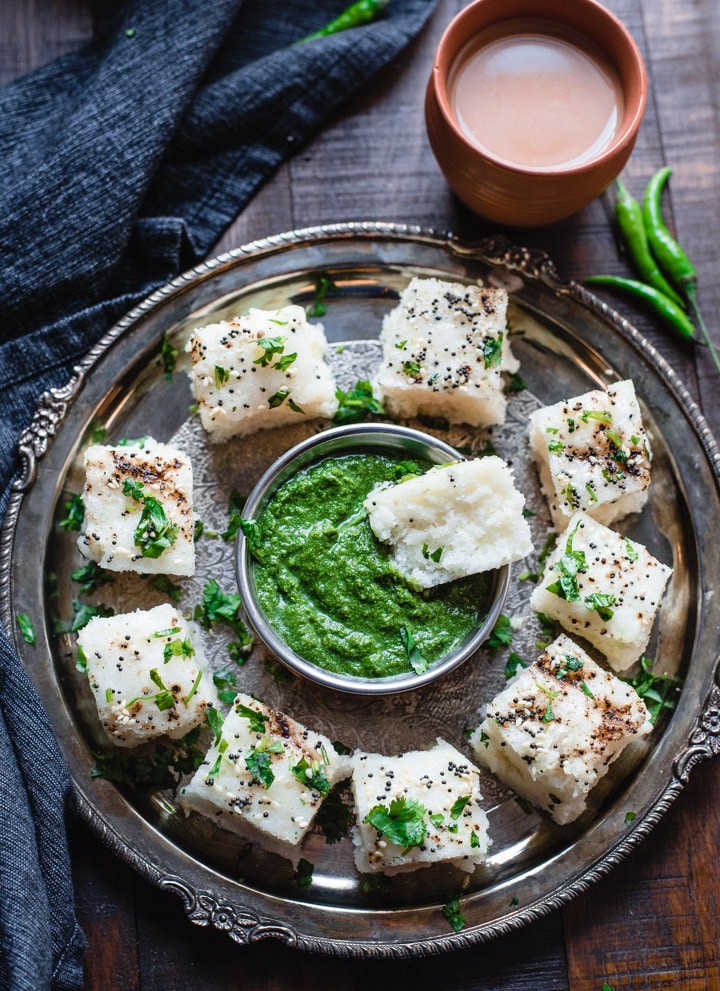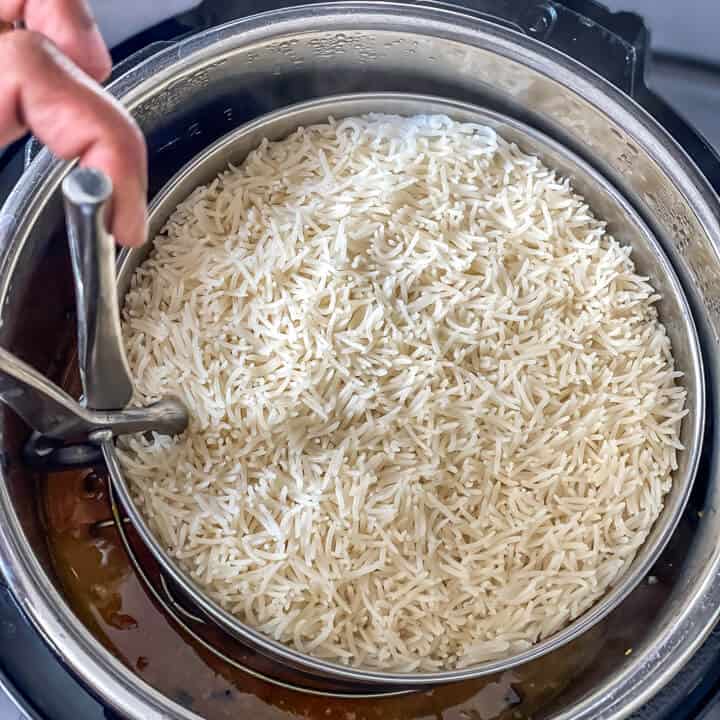Complete Guide: Pot-In-Pot cooking with Instant Pot
Note: This post contains affiliate links. As an Amazon Associate I earn from qualifying purchases.
Follow this complete guide to learn the Pot-in-Pot cooking (PIP) method in the Instant Pot and learn how to bake or cook multiple dishes at once!

What is Pot-in-Pot pressure cooking?
Before Instant Pot or electric pressure cookers were introduced to the market, most households used a stovetop pressure cooker. If you grew up in India, you must have noticed your mom placing a small container of rice over dal, and cooking them together in the cooker.
That’s essentially the concept of pot-in-pot cooking, which has carried over to the Instant Pot – a smaller container of food is cooked by placing it on a trivet inside the inner pot.
There are two common ways to use this technique –
- Cook multiple dishes at once – Use the inner pot to cook a liquid-based dish and cook another one in an oven-safe container on the trivet.
- Baking / Steaming – Bake/steam cakes, cheesecakes, delicate vegetables, meat, and seafood by cooking them in a container that is placed on the trivet inside the inner pot. The inner pot should have at least a cup of water for 6-quart and 1.5 cups of water for 8-quart.
If that’s got you interested, let me share a few reasons why learning pot-in-pot cooking makes sense.
Benefits
- You can cook two dishes at once – Cooking multiple things at the same time saves time and electricity.
- Save money – Does the job of two Instant Pots at once. No need to buy a second Instant Pot or an additional inner pot – all you need is an oven-safe container.
- Rice comes out better – Basmati rice cooked pot-in-pot is fluffier than rice made in the inner pot.
- Perfect technique for baking cakes/cheesecakes and steaming delicate food such as cauliflower, seafood, etc.
- Great for reheating rice without dirtying the inner pot – just use any oven-safe container and pressure cook.
- Prevents burn error – This method can prevent thick and creamy sauces from burning since the food does not directly touch the inner pot.
- Less messy – Make oatmeal pot-in-pot instead of using the inner pot. When the oatmeal is cooked, just remove the container, and then your inner pot is ready for the next dish without needing any extensive cleaning.
Equipment needed
You’ll need an Instant Pot to get started :-). If you don’t own one, get a 6-quart one for a family of 4.
For pot-in-pot cooking, all you need is a trivet and an oven-safe container that’ll fit inside the Instant Pot. You may already have some of these accessories in your house that you can repurpose to do the job.
I don’t use the trivet that comes with the Instant Pot – it does not elevate the dish enough. You need the trivet to be over 2.5 inches tall so that the container kept on it does not touch the contents of the inner pot.
Egg rack / steam rack – This steam rack is great for boiling eggs as well as to use as a trivet.
Stackable Insert Pans – These two-tier stackable stainless steel insert pans allow you to cook a variety of foods simultaneously. It is a great choice for steaming vegetables, rice, meat, and fish and also for reheating. You can use any steel container you own. The recommended diameter for any steel bowl would be less than 7.5 inches for a 6-quart Instant Pot.
Tongs – This tool comes in handy when you need to handle hot pans and pots.
Pressure cooker sling – This sling makes it easy to remove bakeware from a pressure cooker. I found it to be useful when making this delicious date cake. It also keeps your bakeware above the cooking water. Use it when you are baking cakes, lasagnas, cheesecakes, etc.
Baking pan – This 7-inch springform pan is perfect for both the 6Qt or 8Qt pressure cookers for making cakes and cheesecakes.
Here’s an image of all the Instant Pot accessories I own that I use for pot-in-pot cooking.

How to cook Pot-in-Pot with Instant Pot
Here are the two ways I use the pot-in-pot method to cook in the Instant Pot
Steaming and baking
You can use the pot-in-pot technique to steam idlis, dhokla, khaman, and even make a cake. Here’s how you do it –
- For a 6-quart Instant Pot, add at least a cup of water to the inner pot. Depending on the cooking duration, you may have to add more.
- Place the trivet in the inner pot.
- Place an oven-safe container with food over the trivet.
- Set the timer and pressure cook.
Here are a few dishes you can make using this technique. Click on the recipe links below to see how it is implemented.
- Instant Pot Idli
- Date cake
- Khaman
- Dhokla
- Eggs
- Lasagna
- Oatmeal
- Pot-in-Pot yogurt
- Instant Pot baby food






To cook multiple dishes
What I love about the pot-in-pot method is that it lets you cook multiple dishes at once. I’ll walk you through an example of making dal and rice.
- Add ingredients for dal in the inner pot. Here’s the recipe for tadka dal for you to follow along.
- Place a trivet over it.
- On top of the trivet, place a smaller container with rice. No need to cover it.
- Close the cooker and set the cooking time. The cooking time should be set based on the food that is cooked in the inner pot. As the liquid in the inner pot heats up, the resulting steam cooks the rice too.
- Pressure cook. Once the cooking cycle is complete, remove the inner container carefully using tongs.
A few things to remember –
- Always set the pressure cooking time based on the food that is being cooked in the inner pot.
- Containers placed over the trivet take longer to cook since they get less direct heat. Always place the dish that takes longer to cook in the inner pot.
- It also means that the cooking times of the two dishes to be cooked don’t have to be an exact match, but they do need to be within the 5-10 minute range.






Examples of cooking Indian food pot-in-pot
- Salmon tikka masala – cook the gravy in the inner pot while the salmon cooks over the trivet.
- Basmati rice and dal – For any dal recipe that calls for moong or tuvar dal, Basmati rice works great, as shown in the example above.
- Pulses and brown rice – If you are making pulse-based curries that take over 20 minutes to cook, such as rajma, or chana masala, cook your brown rice on the trivet.
- Butter chicken with Basmati rice – Any chicken dish can be cooked with Basmati rice on the trivet.
- Sambar with a stacked container containing veggies. I cook vegetables in a container on the trivet so that they retain their crunch. If you are using an 8-qt Instant Pot, you could also cook rice along with the veggies. Make sure the rice is in the lower container, and then stack the container with veggies over it.
- Potatoes – smaller ones with dal and bigger ones when cooking pulse-based dishes such as channa masala and rajma masala.
Pot-in-Pot cooking recap
- Always start with liquid at the bottom – It can be a curry, dal, or even water. There needs to be some kind of liquid in the inner pot for the pressure cooker to create steam to cook. On the other hand, the container kept over the trivet doesn’t need water for it to cook – you can steam veggies or meat without liquid.
- Cook food with cooking times that are in the same 5-10 minute range; otherwise, it can lead to over/under cooking.
- Cook delicate food or the ones that cook quickly over the trivet – Containers placed on the trivet get less direct heat than the ones in the inner pot. So it is best to place delicate food like fish and easily cooked veggies in the container kept over the trivet.
- Covering the smaller container while cooking will increase the time it will take for the food to cook.
- No need to increase or decrease the amount of liquid used – The amount of liquid required remains the same irrespective of whether you are cooking pot-in-pot or using the inner pot.
- Avoid denser foods like thick cuts of meat – it will take a long time to cook pot-in-pot, and it is not worth the time.
- Slowing down cooking time – If you notice that the food kept over the trivet is turning into mush, cook it covered. That should reduce the amount of heat it receives and slow down the cooking.
- Cooking times can vary depending on the container used – Different containers will take different times to cook (stainless steel heats up faster than glass), so you may have to adjust the time accordingly.
Frequently asked questions
You can technically use any oven-safe containers (steel ones, silicone baking dishes, metal pans, etc), within Instant Pot. Oven-safe glass containers can also be used, but there is always a possibility that they will crack, so use them with caution.
Most folks use Pyrex oven-safe containers without any issues. I don’t use Pyrex bowls because I am worried they will crack. Instead of glass, I prefer stainless steel because it is safer and it cooks faster. If you decide to use oven-safe glass bowls, make sure it is free from scratches and cracks. I highly recommend reading Pyrex’s safety guidelines before you get started.
When using the pot-in-pot cooking technique, the cooking time for ingredients placed in the inner pot will not change, but since the container placed over the trivet is further away from direct heat, it’ll need 3-5 more minutes to cook. Always cook food with longer cooking times in the inner pot and the one that cooks quickly over the pot on the trivet. This gives the food kept over the trivet additional time to cook.
Recommended Resources for Instant Pot
If you are new to Instant Pot, then check out this beginner’s guide to Instant Pot. Here are some of our popular posts from this series.






